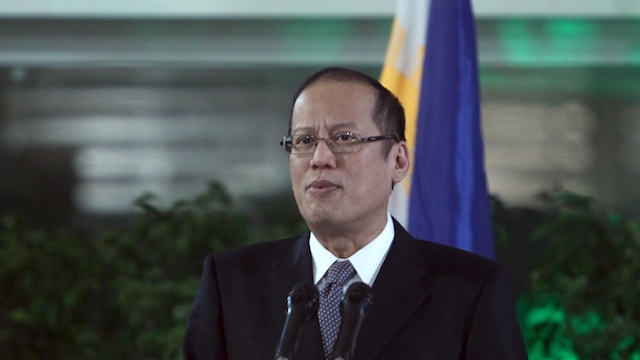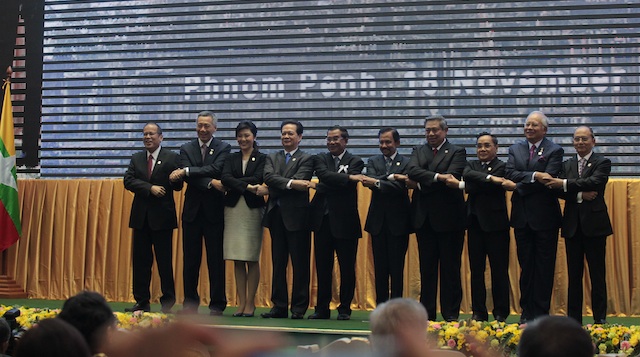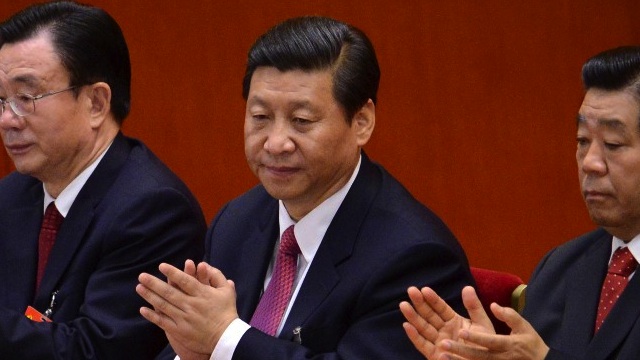SUMMARY
This is AI generated summarization, which may have errors. For context, always refer to the full article.

MANILA, Philippines – This is Round 2 for ASEAN and China.
After the last Association of Southeast Asian Nations (ASEAN) Foreign Ministers’ Meeting last July in Cambodia failed to produce a joint communique over the South China Sea issue, the Philippines will have another swing at the same issue at the 21st Summit of the regional bloc that kicks off on Sunday, November 18, in Phnom Penh.
President Benigno Aquino III is expected to raise the concerns of four ASEAN member countries (the Philippines, Brunei, Malaysia and Vietnam) regarding China’s claim over 90% of the maritime area.
Aquino wants to build a consensus within the regional bloc to tackle the issue of China’s alleged encroachment in the region’s most disputed area, with Chinese ships venturing well into the 200 nautical mile boundaries established by the United Nations Convention on the Law of the Sea (UNCLOS), signed by all concerned parties including China and Taiwan.
Will Manila’s efforts be more successful this time, or will Beijing manage to exert enough pressure over its strongest regional ally for Cambodia to block a joint statement, as it did in July?

Push for COC
Before the president is set to present the case of the Philippines at the plenary, Foreign Affairs Secretary Albert del Rosario on Saturday, November 17, made it clear that maritime security is still a serious concern for ASEAN.
“Any disruption of the sea lanes of communication and traditional maritime trading routes would affect freedom and safety of navigation and impede lawful commerce in our oceans and seas, making regional maritime collaboration imperative,” Del Rosario said at the 2nd Foreign Ministers’ Meeting hosted this year by Cambodia.
Del Rosario said the adoption of the ASEAN’s 6-point principles on the South China Sea (West Philippine Sea) underscores ASEAN’s capacity to resolve disputes peacefully.
Aquino plans to urge member countries to set aside their differences and draft the code of conduct (COC), a binding mechanism to implement the non-binding Declaration on the Conduct of Parties in the South China Sea, signed in 2002 and which so far has been unable to settle the issue.
ASEAN Secretary-General Dr. Surin Pitsuwan agreed and said on Saturday that the new COC must be “sanctified, to be binding, to be ratified at the end of the process, whenever that is.”

United ASEAN
Before leaving for Cambodia, the Philippine president urged ASEAN member countries to present a united front against China over the South China Sea when both sides meet at the East Asia Summit, one of the regional bloc’s side meetings.
ASEAN must speak with one voice, Aquino said.
But despite this call for unity, the fact is that the organization has so far failed to address the matter with consensus, with non-claimant countries such as Cambodia preferring to not rock the boat with China instead of defending the rights of fellow ASEAN member countries.
Indonesia has been sending out feelers to try to mediate between the two positions, but those efforts have come up with scant results and the divide remains.
Thailand, another powerful voice within ASEAN, is opting to not take sides as the kingdom is embroiled in its own territorial dispute with Cambodia over a border temple, while Singapore will be careful to not anger China after it had to clarify its position following a confusing statement of support for the Philippines that was later retracted.

China under new leadership
The ASEAN Summit will also be the first high-level international meeting involving China since the Communist Party Congress that formally initiated the handover of power from President Hu Jintao to Vice President Xi Jinping.
Neither Hu nor Xi are in Cambodia but China’s leadership change is also expected to be discussed in Phnom Penh, even if Xi has not hinted at any major policy shifts regarding the South China Sea for when he takes over as President in a few months.
On top of its row with ASEAN, China has similar maritime and territorial disputes with Japan and South Korea over islands in the East China Sea, and the tensions now are so high that the three countries have cancelled a joint meeting they had been holding since 1999.
The leadership reshuffle is widely expected to have virtually no effect over China’s current foreign policy of encroaching their settlements in the South China Sea, unless ASEAN is able to convince Beijing to pursue a multilateral approach to solving the row, an initiative that is precisely what China does not want.
So what’s in store for the Philippines? Most likely, that the tug of war will continue and the dispute will drag for the next few months. – Rappler.com
Add a comment
How does this make you feel?
There are no comments yet. Add your comment to start the conversation.